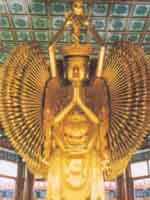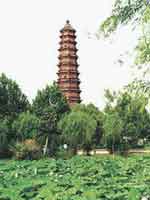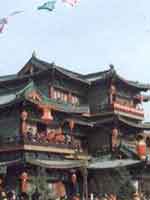|
Forgotten Ancient Capital
(Beijing Today)
Updated: 2004-05-24 11:33
|

Da Xiangguo Temple
|
To the newly arrived traveler, Kaifeng appears to be something of a sleepy backwater, left behind by China’s modernization drive. This is good news for those who preferto escape the tourist crowds and explore at their own, leisurely pace. Kaifeng is a charming historical city with many hidden treasures waiting to be discovered.
One of China' seven ancient capitals, Kaifeng, a city f more than 5 million in Henan Province, has a history of more than 2,300 years. Originally called Daliang, it was capital of the Wei Kingdom during the Warring States Period, and from 361 BC to 960 AD was capital of a succession of minor dynasties.
The economy of the city prospered during the Sui (581-618 AD) and Tang (618-907 AD) Dynasties, and peaked during the Northern Song Dynasty (960-1127 AD). In 960, it was renamed Dongjing (eastern capital), and became the capital of the Northern Song Dynasty. Nine emperors ruled from the city for 168 years.
With a population of over 1 million, Kaifeng at that time ranked among the most flourishing metropolises in the world. In fact, the layout of Beijing in the early years of the Ming Dynasty mimicked that of Kaifeng.
The city is also the earliest place in China where Jewish people settled. Archeological evidence shows the first Jews arriving as early as the 8th century. Many travelers, including Marco Polo in the 13th Century, wrote of meeting Jewish people.
The first synagogue was built in Kaifeng in 1163, and was destroyed and rebuilt many times. The last synagogue was destroyed between 1850 and 1866. During the Ming Dynasty (1368-1644 AD), seven Chinese surnames were conferred upon the Jews, by which their descendants are identifiable today: Ai, Lao, Jin, Li, Shi, Zhang and Zhao. Today, there are still around 200 of their descendants living in Kaifeng.
City sights
|

The Iron Pagoda
|
Many buildings of the Northern Song Dynasty survive in Kaifeng. Standing on a hill north of Henan University in the northeastern part of the city, the Iron Pagoda (Tieta) was built in 982.
The pagoda was originally part of Kaibao Temple. In 1049, the timber frame was covered with iron-colored glazed tiles, hence its name.
The thirteen-story pagoda rises to about sixty meters. On the brick base are exquisitely carved patterns of animals, Buddhist motifs and flora.
Open: 8 am to 6 pm daily
Admission: 15 yuan to enter the park, an additional 3 yuan to climb the pagoda
In the western section of Ziyou Lu can be found one of the most famous Buddhist temples in China – Da Xiangguo Si (Great Xiangguo Temple). It was first built in 555, but was destroyed during civil war.In 711, a monk built a new temple on the site and donated a three-meter-high Buddha statue.
In the Song Dynasty, the temple was favored by the emperors and was expanded in scale. It became a key center of Buddhism, where monks from India, Japan and Korea came to meet the emperor.
Inside lies a huge black stone block called the Dragon Stone, around which thirteen rolling dragons have been engraved. Wax figures and portraits of Song emperors are on display in the hall.
A park established on the site in 1963, designated as a provincial level relic, is a popular place for people to meet and play chess and mahjong.
Shopping
|

Yu Street
|
The best place for souvenir shopping in Kaifeng is Yu Street of the Song Dynasty Capital, newly built next to Longting Gongyuan. The original Yu Street once led to the Imperial Palace. The reconstructed street maintains a distinctive Song Dynasty architectural style, and deserves a visit even if you walk away empty-handed.
The main local products on sale are embroidery, porcelain and New Year’s paintings. Many ancient Chinese cities have their own distinctive style of embroidery, and Kaifeng is no exception. The local embroidery, which originated in the Song Dynasty, is known as bian xiu (bian stands for Kaifeng, xiu means embroidery.)
Song porcelain holds a special place in the hearts of collectors. Today, any visitor to Kaifeng can buy guan yao ci qi well made copies of that style.
Another local specialty, from Zhuxianzheng, a town near Kaifeng, is Zhuxianzheng muzhi nianhua – Lunar New Year (Chinese New Year) paintings. This art form has a history of 800 years, and is produced today by the same methods it has been for centuries. Another good place for strolling and occasional souvenir buying is the open-air temple market near Xiangguo Temple.
Snacks
A must for a trip to any destination in China is sampling the local delicacies – and as a former capital, Kaifeng definitely has its own distinctiv food specialties.
Among these are li yu bei mian fish with very thin fried noodles on top, wuxiang doufu gan – five spiced dried tofu,rouhe – fried vegetables and pork (or mutton in its Islamic version) stuffed int a flat bread.
Some local delicacies have imperial roots, such as tongzi ji ?specially cooked chicken, and tao si bao, a dish consisting of a whole quail stuffed in a whole pigeon, inside a whole duck or chicken.
One of the best places to try these delicacies in an authentic atmosphere while watching the locals is the Drum Tower Night Market, near the corner of Gulou Jie and Madao Jie.
Relatively few foreigners visit Kaifeng, and they still attract considerable attention from the locals, so be prepared, and smile ?it is a good way to communicate even without knowing the language.
|
